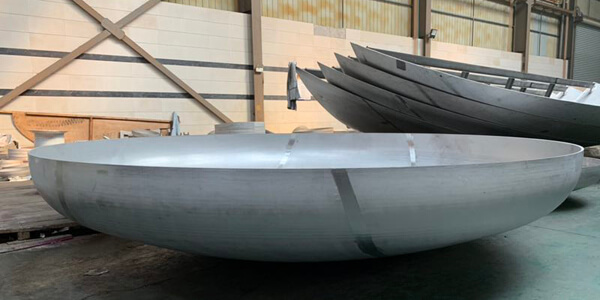In the design and manufacturing process of the head, in order to meet the needs of various strength and other indicators, heat treatment technology pretreatment is required after the head is formed. Therefore, heat treatment has become a key technology that cannot be ignored in the design of pressure vessels. The following will discuss the heat treatment in the design of dish end.
Basic process technology of heat treatment
To carry out heat treatment, it is necessary to cooperate with each other in the heating, maintaining temperature, and cooling stages, and it is also a process that requires a compact process, mainly including: first, the heating method. The general heating method includes direct heating and indirect heating. The direct heating includes liquid, gas, electric heating, etc. Indirect heating includes the use of liquid metal or salt floating particles for indirect heating. Second, when selecting the temperature value and controlling the temperature, it is necessary to control the temperature in different reaction sections when manufacturing the head to ensure that it is in the corresponding area, so as to ensure the maximum lifting of the metal The material strength meets the quality requirements of the finished head. Third, the cooling process. For different purposes, different structure types and different manufacturing materials of the head, it is necessary to implement different speed cooling according to the above specifications in the design and manufacturing. Generally, quenching is chosen because of its fastest cooling rate. Not only can the martensite structure of the steel parts be guaranteed, but also the wear resistance, strength and hardness of the head can be improved. In this way, the follow-up work of heat treatment can be carried out smoothly. The normalizing cooling rate is relatively slow, which can improve the processing and cutting performance of the material, and can also improve the overall mechanical properties of its low-carbon steel.
Analysis of Head Design in Heat Treatment
1. Austenitic stainless steel material
Based on relevant specifications, austenitic stainless steels are non-heat treatment welds. How to do the heat treatment after connection, and how to set up the heat treatment after the connection is executed, but there is a lack of corresponding standards. Generally speaking, austenitic stainless steel has good plasticity and toughness, its residual stress is not generated, and there is no problem of cold work hardening. In practice, the pressure needs to be relieved, heat treatment at 600-620 ° C, and heat preservation for 2 hours. For austenitic stainless steel, in the range of 400-850 ℃, if the cooling rate is too slow, there may be problems of intergranular corrosion, which may lead to sensitization of the substance. In order to improve the corrosion resistance requirements, or when the ambient temperature increases, considering the actual supply needs, it is necessary to analyze and discuss the corresponding affairs and deal with the corresponding affairs so that the quality requirements of the head can be met.
2. Composite plate material
How to perform post-weld heat treatment of composite plate heads needs to be analyzed. Generally speaking, if the base material needs to be heat-treated after welding, the use of composite plates to produce heads requires corresponding operations. Before performing heat treatment, first analyze the impact of the composite plate material on the heat treatment, and then analyze the impact of the heat treatment on the corrosion resistance. Generally choose stainless steel plate, which will have a certain effect after post-weld heat treatment, and gradually carbonized, and may even appear σ, resulting in damage to the performance of the composite plate material, destroying its mechanical properties and corrosion resistance. Therefore, when choosing a stainless steel cladding plate, post-weld heat treatment is required. In the development of post-weld heat treatment, it is necessary to analyze the requirements for the material itself and consider how it will affect the corrosion performance of the material.
3. The focus of heat treatment technology for head design
In regard to the heat treatment of head design, we also need to consider: first, welding components during heat treatment. Second, in the manufacture of heads, heat treatment can be performed only after the technical inspection and welding process meet the standard requirements. Third, based on different solder joints and materials, it should be implemented according to the corresponding heat treatment technology, and finally determine whether it needs to be heat treated.
All in all, the continuous development and progress of science and technology has made the head manufacturing technology gradually become a comprehensive and highly scientific technology in our field of vision, and its actual operation has received widespread attention. The implementation of the heat treatment process itself is related to personal safety and property safety. With the further improvement of the heat treatment technology requirements, it is necessary to be able to lay a good foundation for the design of the head through effective technical innovation, and ultimately improve the stability of the pressure vessel and safety.
